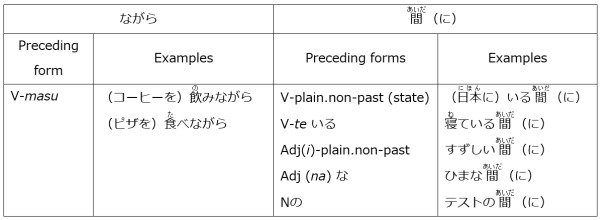【注意書き掲載テスト】A. Time expressions (vol. 2)
[Important Notice] GID on this website will cease publication on November 30, 2024. From December onwards, it will be replaced by a paid digital version. Thank you for your understanding.
1. 時 vs. 時 に (L.11 #3)
X
日本 では、家 を出 る時 (に)、「行 ってきます」と言 います。(In Japan, you say “行 ってきます” when you leave your house.)日本 では、家 に帰 った時 (に)、「ただいま」と言 います。(In Japan, you say “ただいま” when you get home.)日本 にいる時 (に)、台 風 が来 ました。(There was a typhoon (lit. A typhoon came) when I was in Japan.)私 は試 験 の時 (に)、いつも緊 張 します。(I always get nervous when there’s a test.)
-
A: どんな
時 に緊 張 しますか。(In what kind of situations do you get nervous?)B:
私 は試 験 の時 に緊 張 します。(I get nervous when there’s a test.)
(6) provides an additional example in which
困 った時 に助 けてくれる友達 が本当 の友達 です。(A real friend is a friend who helps you when you are in trouble.)
Because
私 はおいしい物 を食 べている時 が一 番 しあわせです。(I’m happiest when I’m eating something delicious.)日本 のおふろに入 る時 の正 しいマナーを教 えてください。 (Please teach me the correct manners for when you take a Japanese-style bath.)初 めてライブを聞 いた時 から私 はこの歌手 のファンです。 (I’ve been a fan of this singer since the time when I first listened to her live performance.)
2. V-te から (L.11 #6) vs. 後 で (L.12 #2)
Both V-te から and V-plain.past
-
a.
私 たちは映画 を{見 てから/見 た後 で}カフェでコーヒーを飲 みました。(We had some coffee at a café after watching the movie.)b.
私 は友達 が{帰 ってから/帰 った後 で}母 に電話 しました。(I called my mother after my friends had left.)
The basic difference is that V-te から is commonly used when an action is taken (or an event takes place) after another action or event with no or little time between the first action/event and the second one, while V-past 後で simply indicates that an action is taken (or an event takes place) after another one.
V-te から is typically used when the first action or event triggers the second one, as in (2), or when the first action or event is essential to the second action, as in (3). V-past
- <At a test site>
私 が「始 めてください」と{言 ってから/×言 った後 で}始 めてください。(Please begin after I say, “Please begin.”) - この
肉 はよく{焼 いてから/×焼 いた後 で}食 べてください。(Please grill this meat thoroughly before you eat it. (lit. As for this meat, please eat it after grilling it thoroughly.))
One restriction for V-te から is that it cannot be used when it represents an action and the main clause represents an event, as in (4). In this case, V-past
宿題 を{?? してから/した後 で}母 から電話 がありました。(I had a phone call from my mother after I finished my homework.)
Another note is that V-te から can also mean “since (the time when) X V-ed,” but V-past
足 のけがを{してから/× した後 で}速 く走 れなくなりました。(I haven’t been able to run fast since I hurt my leg.)
3. ながら (L.13 #4) vs. 間 (に) (L.16 #6)
Both ながら and

Second, in V1ながらV2, the subject of V1 and that of V2 must be the same, while there is no such restriction in S1
- ×
母 がそうじをしながら、私 は料理 していました。 母 がそうじをしている間 、私 は料理 していました。(I was cooking while my mother was cleaning.)
Third, in V1ながらV2, V1 and V2 represent actions that are taken simultaneously or concurrently, as in (3) and (4).
- いつもスマホで
音楽 を聞 きながらそうじをします。(I always listen to music on my smartphone while I clean.) - 兄は
働 きながら大 学 院 で勉強 しています。(My older brother is working through graduate school (lit. works while he is studying at graduate school).)
On the other hand,
日本 にいる間 に日本中 を旅行 したいです。(I’d like to travel all over Japan while I’m there (lit., in Japan).)- ルームメートがゲームをしている
間 、私 は日本語 の勉強 をしていました。(I was stdying Japanese while my roommate played video games.) 毎朝 すずしい間 にジョギングをします。(I jog while it’s cool every morning.)面 接 の間 、あまり緊張 しませんでした。(I didn’t get very nervous during the interview.)
